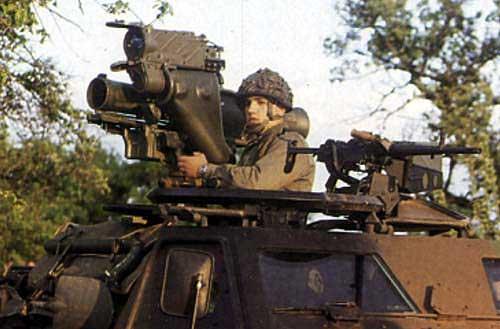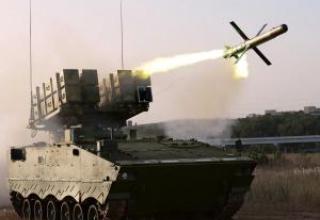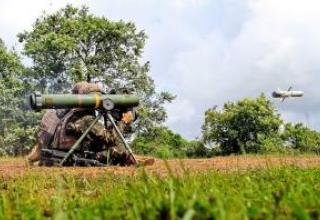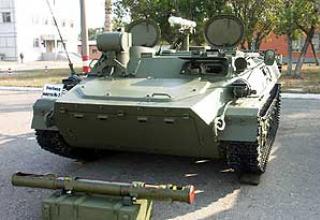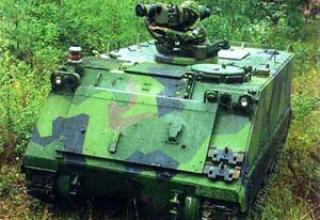The Milan complex was developed on the basis of the requirements of the German and French armed forces and the general NATO command requirements for such weapons. As a result, the international association "Euromissile" developed a system which, thanks to its high TTH, has become the most widely used (after the "TOW") anti-tank missile in various countries. The Milan anti-tank missile system is in service with the land forces of 40 countries, including Germany, France and other NATO countries.
The following basic requirements were set forth in the Milan APC modernization program adopted in 1974:
- to improve the effectiveness of the BC missile on new armor types;
- increased guidance system interference immunity;
- ensuring compatibility of the upgraded missile with the PU and thermal sight without modification;
- maintaining the same range of action.
As a result, samples of advanced missiles designated "Milan-2" were created. Mass production of these missiles began in 1984 and in 1985 began supplying them to the armed forces of Germany and France.
Composition:

The combat unit of the K-115 "Milan-2" missile with a BB charge of greater mass and power than the previous BC. The effectiveness of the BC K-115 has been significantly increased by increasing its diameter from 103 to 115 mm, using a more powerful BB (octolite) and increasing its mass from 1.2 to 1.8 kg, increasing the BC blasting distance from the obstacle from 2 to 2.5 calibers by installing a tip in the nose of the missile, which simultaneously provides reliable BC blasting at angles up to 80 ° from normal. The charge of the BC has a conical cumulative notch with an angle of 50°, lined with a 1.9 mm thick copper shell.
The armor penetration of the cumulative BC significantly depends on the distance of the explosive charge explosion from the obstacle. When a new BC is detonated with a 280 mm tip, the armor penetration is more than 800 mm (homogeneous armor). When detonated in the laboratory at a distance of about 10 calibers, it was more than 1000 mm, but this efficiency can be practically achieved only with a non-contact fuse.
When piercing the homogeneous frontal armour of modern tanks, the new BC of the Milan-2 missile retains residual armour penetration up to 200 mm, which is necessary for armour-plating. Practical application of "Milan-2" missiles showed that they have additional striking ability due to unburned fuel of the marching engine. The fuel burns out within 12 seconds at a temperature of 1125 - 1200 ° C, and when the missile hits within this time to targets such as ships or fortifications, it becomes the main striking factor. In addition, although the missile's maneuverability is limited (angular velocity of flight direction change is no more than 20 mrad/s), it can be used to hit helicopters on the counter course or in hover mode. In this case, the missile can climb to a maximum altitude of 380 m at a range of 1800 m.

To ensure the use of "Milan-2" complex in night conditions it is equipped with the thermal sight "Mira" (Milan Infra-Red Marter). The sight provides application of the complex without reducing its effectiveness at night and in limited visibility conditions, as well as for detection of disguised targets. The sight can be used during daytime as well. The sight can be quickly mounted by means of an adapter on the PU on the daytime sight body without tools. Thermal image of objects in the wavelength range of 8-13 µm is received by the scanning mosaic receiver of the sight radiation and converted into electrical signals. The signals are processed by the electronic unit, amplified and received by LEDs, which reproduce the thermal image superimposed on the real optical image. The sights of Milan complexes of the French Army are equipped with a cooling device operating from a compressed gas cylinder. Cylinder mass is 700 g, cylinder gas pressure is 329 atm. At a temperature of 15 ° C provides cooling to 77 ° K.
The German Army chose a cooling device for the sight, developed by the company AEG (Germany) instead of a gas cylinder. The power supply is independent from the lithium battery. The power supply battery and a gas cylinder (0.33 or 0.66 l capacity) ensure continuous operation of the sight for 2 hours, after which it can be quickly replaced. It is easy in maintenance and operation, designed for working conditions in the temperature range from -40 to +52 ° C. Its reliability corresponds to the reliability of other elements of the complex. Target detection is provided at a range of 4000 m, target identification at 2. 3x2.3 m (the size of the tank in front), launch and guidance of the missile at a range of 2000 m. A man can be detected at a distance of up to 600 m. Optical field of view 3° x 6°; spatial resolution 0.175 mrad; minimum detectable temperature difference 0.16 ° C; readiness time for operation after switching on 30 sec. DC supply voltage (7.2+0.1V). Weight of the sight with a battery and a gas cylinder about 9kg. Overall dimensions are 540x158x258 mm. The sight is in serial production, is in service since 1983 in the Army of France, Germany, Great Britain, as well as in the Army of six more countries. In these three countries it is equipped with 2100 anti-tank infantry units. Developers of the sight are "Euromissile" association (general contractor) and firms of Germany, France and Great Britain: AEG (onboard cooling device), "Marconi" (detector unit), MVV (nickel cadmium battery, circuit diagram), "Siemens" (electronic unit, cables), TRT (reamer unit, integration of sight systems).
AEG has also developed an onboard cooling device for Mira sight for Milan carrier vehicles. Its weight is 1 kg, power consumption is 30 W, power supply from nickel cadmium battery is 15 kg and capacity is 7 A-h, which provides continuous operation time of the sight for 3 hours. In the SW of Germany this device is equipped with APC M113, BMP "Marder" and vehicles with high cross-country ability, on which a significant part of Milan APC is installed. The cooling device can also be connected to the power supply of the electrical equipment of the carrier vehicles.
To increase noise immunity of the complex, an additional communication channel was introduced into the guidance system. The rocket is equipped with an improved gyroscope with a light-emitting diode and a new electronic unit, which allowed improving the guidance process.
The advantages of the complex also apply to it:
- the possibility of its use by various infantry units;
- rapid deployment in any firing position and 10-12 seconds after that, the ability to launch a missile;
- ground application and can be mounted on light vehicles without modification;
Along with the advantages of the complex there are some disadvantages that appeared during the tests, in combat conditions and in connection with the emergence of new types of armor. These include:
- a relatively large mass for a worn complex;
- sufficiently strong smoke formation of the missile's marching engine, which causes the sight to close for 1.5 to 3 seconds after launch, depending on the weather conditions;
- the possibility of the missile losing its IR tracking device receiving the radiation from its tracker against the background of intense radiation in real battlefield conditions (e.g. against the background of burning machines);
- Milan-2, like other existing PTUR missiles, proved to be ineffective under reactive armour action.
In connection with these shortcomings and in order to extend the life cycle of the complex "Milan" proposed ways to further improve it. First of all, the task is set to ensure the necessary effectiveness of the missile when acting on the rocket armor.
The firm MVV (Germany) has developed a new BC for the "Milan" rocket, containing two cumulative charges of BB. The first, an auxiliary charge with a diameter of about 30 mm is placed in the telescopic tip of the BC at a distance of 450 mm from the second, the main charge placed behind the first in the BC body. The auxiliary charge, which is detonated when the tip strikes the barrier 0.5 ml s earlier than the main charge, is designed to destroy a layer of reactive armor, the second charge - to penetrate the main armor. The rocket with the new BC was designated as "Milan-2T" (tandem BC) or "Milan-3".
MVV has also developed a new multi-purpose BC for hitting light armored vehicles, manpower and equipment. This BC contains a cumulative explosive ordnance charge capable of penetrating armor up to 350 mm thick, and approximately 1000 steel balls with a diameter of 4 mm, placed around the explosive ordnance.
Other possible improvements to the Milan complex include:
- Increasing the range of the missile to 4000 m (with an increase in the mass of the missile to 9.5 kg);
- equipping the BC of existing missiles with a non-contact (laser or pulse Doppler) fuse, which will increase the armor penetration of 103-mm and BC by 25-30%;
- development of a new 3 kg BC for penetration of reactive and combined armour;
- equipping rockets with an IR tracer with modulated radiation or a laser diode with encoded radiation to improve the interference immunity of the tracking device;
- replacement of analogue tracking and decoding devices with digital ones, which will enable complex coding of IR trace radiation and programming of the tracking device to receive only such radiation. This will increase the reliability and interference immunity of the guidance system, the sensitivity of the missile to control commands;
- installation of a smokeless rocket engine, which will reduce the minimum launch range of the missile and demasculating signs;
- reduction of the size and weight of the missile carrying container (with four missiles, its weight is 82 kg) by more than 3 kg;
- reducing the mass of PU by using kevlar and composite materials instead of metal in the design;
- reduction in size and weight of the Mira thermal sight due to the use of electric cooling method instead of gas and other improvements.
Characteristics:
| Range of fire, m | 25-2000 |
| Maximum flight speed, km/h. | 720 |
| Missile flight time at a range of 2000 m, s. | 12.5 |
| Missile flight time at a range of 1000 m, s. | 7.3 |
| The weight of the rocket, kg | 6.73 |
| Weight BC, kg | 3.0 |
| Weight of explosives BC, kg | 1.8 |
| Weight of the rocket with the launch tube, kg | 12.0 |
| PU weight with tripod, kg | 16.5 |
| Weight of sighting unit, kg | 4.2 |
| Speed of fire, start/min. | 3 |
| Temperature range of combat application, ° C | -40...+52 |
| Technical reliability, % | over 95 |
| Armor penetration under the action of homogeneous armor, mm | 1000 |
Testing:
Of the more than 50,000 launches of Milan missiles (training and combat missiles) carried out in various conditions, 92% ended in a direct hit. The effectiveness of the complex was demonstrated in combat conditions: Iraq since 1980, Syria and Great Britain in 1982, French troops in Lebanon in 1984, Chad in early 1987. With nine PU units of the Chadian land forces hit more than 100 tanks and other vehicles in Libya, using about 250 missiles "Milan-2".
Sources:
- Armada International, 1990, №2, PP. 22-34.
- International Defense Review, 1989, V.22, №12, PP. 1631-1634.
- Armada International, 1987, № 4, PP.81-86.
- Armee et Defense, 1984, № 63, P. 22.
